Teodorescu P.P. Mechanical Systems, Classical Models Volume I: Particle Mechanics
Подождите немного. Документ загружается.

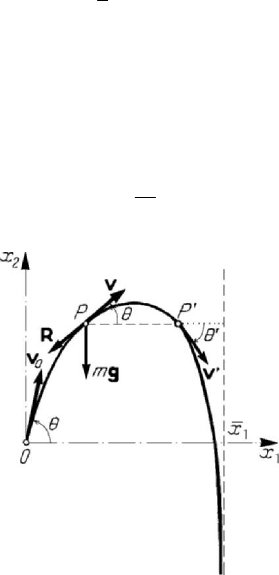
Problems of dynamics of the particle
411
the trajectory coincides with that imposed if and only if
0
0
k
x
=
, so that we may state
Theorem 7.1.1'. The trajectory of a free particle in a resistent medium, modelled by the
relation (7.1.21), is rectilinear if and only if the resultant of the given forces acting
upon it has a fixed direction, and its initial velocity has the same direction.
Analogously, proceeding as in Subsec. 1.1.2, we obtain
Theorem 7.1.2'. The trajectory of a free particle in a resistent medium, modelled by the
relation (7.1.21), is a plane curve if and only if the resultant of the given forces acting
upon it is parallel to a fixed plane (is normal to a fixed direction), and its initial
velocity has the same property.
In the case of a heavy particle
P
in a resistent medium, the equation of motion is
()gvϕ
=
−
rg r,
(7.1.22)
where we assume that – in general – the initial velocity
0
v is not directed along the
vertical of the position of launching (
0
v has not the same direction as g );
corresponding to the Theorem 7.1.2', the trajectory is a plane curve (contained in a
vertical plane). Using Frenet’s trihedron, we may write
[
]
sin ( )vg vθϕ=− + ,
2
cos
v
g θ
ρ
= ,
(7.1.22')
Figure 7.4. Motion of a heavy particle in a resistent medium.
where
θ is the angle made by the velocity v with the
1
Ox -axis. We notice that
cos 0θ ≥ , hence /2 /2πθπ−≤≤; the concavity of the trajectory is directed
towards the negative ordinates (Fig.7.4), so that to
d0s > corresponds d0θ < (the
angle
θ is decreasing). It follows d/d d/dsvtρθ θ
=
−=− , so that the second
equation (7.1.22') takes the form
cosvgθθ=−
.
(7.1.22'')

MECHANICAL SYSTEMS, CLASSICAL MODELS
412
We have thus obtained a system of two differential equations (7.1.22'), (7.1.22'') for the
unknown functions
()vvt= and ()tθθ
=
, with the initial conditions
(
)
00
vt v= ,
(
)
00
tθθ= . Eliminating the time t , we may write the equation
()
d
tan
dcos
v
v
v
ϕ
θ
θθ
⎡
⎤
=+
⎢
⎥
⎣
⎦
,
(7.1.23)
which defines the function
()v θ with the initial condition
(
)
00
vvθ
=
. This equation
of the hodograph of motion, which can be written also in the form
d( cos )
()
d
v
vv
θ
ϕ
θ
=
,
(7.1.23')
is the basic equation of the external ballistics. The equation (7.1.22'') allows then to
determine (usually, one takes
0
0t
=
)
0
0
1
d
cos
v
tt
g
θ
θ
ϑ
ϑ
ϑ
=−
∫
,
(7.1.23'')
wherefrom – afterwards – we may obtain
()tθθ
=
. Noting that
1
dcosdxv tθ=
,
2
d sin dxv tθ=
, there result the parametric equations of the trajectory in the form
0
02
11
1
()dxx v
g
θ
θ
ϑϑ=−
∫
,
0
02
22
1
()tandxx v
g
θ
θ
ϑϑϑ=−
∫
,
(7.1.23''')
where we take
00
12
0xx== if the particle (the projectile) is launched from the origin
O . In the case of an object launched from an airplane at the height h we take
0
1
0x = ,
0
2
xh= ; the initial velocity
0
v is the velocity of the airplane at the moment of
launching the object.
From the second equation (7.1.22') one observes that (
θ is only decreasing and
greater than
/2π− for t finite, hence cos 0θ > ) the velocity v is finite and non-
zero. An extreme value of
v is given by d/d 0vt
=
; we obtain thus () sinvϕθ=− .
Because the velocity
v is finite, from (7.1.22'') it follows that θ has an extreme value
for
d/d 0tθ = , hence for cos 0θ
=
; but the angle θ is decreasing, so that we have
lim / 2
t
θπ
→∞
=− . We notice that for vv
∗
> ,
(
)
1vϕ
∗
=
, we have 0v
<
, the function
()vϕ being monotone decreasing. Hence, the velocity v has an inferior limit (
0v >
)
and a superior one (
vv
∗
≤ ). The trajectory has a vertical asymptote
11
xx= , with
0
2
2
11
0
2
1
lim ( )dxxv
g
π
θ
π
θ
ϑϑ
−
→− +
==
∫
,
(7.1.24)

Problems of dynamics of the particle
413
and the corresponding velocity is given by
/2 0
lim ( )vv
θπ
θ
∗
→− +
=
. Because of the
resistance of the air, we notice that the range of throw of the projectile is smaller.
Besides, for two points
P and P
′
of the trajectory, which have the same ordinate
2
x ,
it results
θθ
′
< ; hence, the two branches (increasing and decreasing) of the
trajectory are not symmetric. Applying the theorem of kinetic energy, we may write
(
)
2
2
d/2 d ()dmv mg x mg v v tϕ=− − , so that, integrating between the points ()Pt
and
()Pt
′′
, we obtain
()
[]
22
1
() ()d 0
2
t
t
vv g vvϕτ ττ
′
′
−=− <
∫
,
wherefrom
0vv
′
>>.
Modelling the projectile as a rigid solid, one can take into account also its rotation,
being led to a deviation from the vertical plane of the trajectory.
In particular, d’Alembert has considered the law of resistance
()
n
vvϕλ= ,
0n >
,
λ being a positive constant with dimension. The equation (7.1.23') leads to
1
1
(cos)
d
(cos)
d
cos
n
n
v
v
λθ
θ
θ
θ
+
+
= ;
integrating, we get
[]
()
{}
00
1/
00 0
cos
cos
1()()cos
n
n
nn
v
v
nv
θ
θ
λε θ ε θ θ
=
−−
,
(7.1.25)
where we have introduced the integral
0
1
d
()
cos
n
n
θ
ϑ
εθ
ϑ
+
=
∫
.
(7.1.25')
For small velocities, one can use Stokes’ law ( 1n
=
); thus, we obtain
1
() tanεθ θ= ,
so that
()
00
00
cos
()
cos sin
v
v
v
θ
θ
θλ θθ
=
−−
.
(7.1.25'')
For velocities till 250 m/s one may take
2n
=
, obtaining Euler’s law; we notice that
(
)
2
1tan
() lntan
2cos 4 2
θπθ
εθ
θ
⎡
⎤
=+ +
⎢
⎥
⎣
⎦
.
(7.1.26)
Let us consider now
n ∈ ; for n odd (
21np
=
−
), we have

MECHANICAL SYSTEMS, CLASSICAL MODELS
414
1
21 221
1
2 ( 1)( 2)...( )
sin
() sec sec
2 1 (2 3)(2 5)...(2 2 1)
p
k
ppk
n
k
pp pk
ppppk
θ
εθ θ θ
−
−−−
=
−− −
⎡⎤
=+
⎢⎥
−−−−−
⎣⎦
∑
,
(7.1.26')
while for
n even ( 2np= ) we may write
1
222
1
(2 1)(2 2)...(2 2 1)
sin
() sec sec
2
2 ( 1)( 2)...( )
p
ppk
n
k
k
pp pk
p
pp pk
θ
εθ θ θ
−
−
=
−− −+
⎡⎤
=+
⎢⎥
−− −
⎣⎦
∑
(
)
(2 1)!!
ln tan
2! 42
p
p
p
πθ
−
++
.
(7.1.26'')
The velocity
()v θ is then easily given by the formula (7.1.25), obtaining the time t
and the parametric equations of the trajectory from the formulae (7.1.23''), (7.1.23''').
Legendre considers the resistance law
()
n
vvϕλμ
=
+ , where ,, 0nλμ > , while
1μ < (otherwise, the particle – without initial velocity – comes against a resistance
mgμ and can no more fall); also in this case, the problem may be solved by
quadratures.
We observe that, by the substitution
[
]
sin ( ) 1/vvyθϕ
+
= , the equation (7.1.23)
reads
23 2
d()
d
() 1 2 ()
dd
v
y
vv y vv y
vv
ϕ
ϕϕ
⎡
⎤
=−−+
⎡⎤
⎣⎦
⎢
⎥
⎣
⎦
;
(7.1.27)
Drach has determined all the forms of the function
()vϕ for which the solution of this
equation may be obtained by quadratures.
1.2.3 Rectilinear motion of a heavy particle
If, in the motion of the heavy particle
P considered above, the initial velocity
vanishes (
0
=v0) or is collinear with g , then the trajectory is rectilinear (along the
local vertical). Taking the
Ox -axis along the direction of the gravity acceleration g ,
the equations (7.1.14) become
()()
2
0000
1
2
xgtt vttx
=
−+ −+,
(
)
00
vgtt v
=
−+,
(7.1.28)
for the motion in vacuum, with the initial conditions
(
)
00
xt x
=
,
(
)
00
vt v= ; taking
0
0t = and
0
0x = , we may write
2
0
1
2
xgtvt=+
,
0
vgtv
=
+ ,
(7.1.28')
without loosing anything from the generality.
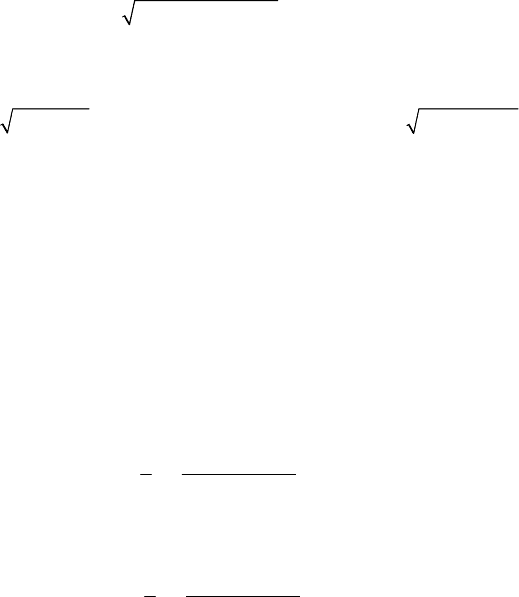
Problems of dynamics of the particle
415
Eliminating the time
t between the equations (7.1.28), we obtain the relation
between the velocity
v and the co-ordinate x in the form
()
2
00
2vv gxx=+ −,
(7.1.28'')
corresponding to Torricelli’s formula (7.1.17). A particle which is falling with the
initial velocity
0
v from a height h (in this case
0
0xx
−
> ) comes down with the
velocity
2
0
2vv gh=+ after an interval of time
()
(
)
2
00
/12/1vg ghv
+
− . A
particle which is thrown up with the initial velocity
0
v (in this case
0
0xx
−
< ) attains
the height
2
0
/2hv g= after an interval of time
0
/vg; after another interval of time
0
/vg, the particle comes back to the initial position with the same velocity
0
v .
In the case of a resistent medium, it is convenient to distinguish between the
descendent and the ascendent motion along the local vertical. In the first case, if we
assume an initial velocity
0
0v > , with the same direction as the Ox -axis, then the
equation (7.1.22) leads to
[
]
[
]
1() ()()vg v g v vϕϕϕ
∗
=− = −
,
(7.1.29)
the velocity
v
∗
being introduced in the previous subsection. It results that
0
0
d
1
() ()
v
v
tt
g
v
η
ϕϕη
∗
=+
−
∫
,
(7.1.29')
and we may obtain
()vvt= ; noting that ddxvt
=
, we get also
0
0
d
1
() ()
v
v
xx
g
v
ηη
ϕϕη
∗
=+
−
∫
.
(7.1.29'')
If
0
vv
∗
< , then () ()vvϕϕ
∗
− is positive at the beginning, while the equation (7.1.29)
shows that the velocity
v increases. From (7.1.29') we notice that for vv
∗
→ we have
t →∞, so that v
∗
is a superior limit for the velocities; hence, the velocity v increases
till this limit. Analogously, if
0
vv
∗
> , then the velocity v decreases till the limit value
v
∗
(in this case 0v <
). We may thus state that, for any initial velocity
0
v , the particle
falls with a velocity which tends to become uniform (tends to
v
∗
for t →∞); if
0
vv
∗
= , then the motion of the particle is uniform.
If a heavy body, which may be modelled by a heavy particle, is launched by a
parachute, then the velocity is – at the beginning – increasing (a motion approximately
uniform accelerated, as in vacuum, the resistance of the air being negligible); when the
parachute is opening, the resistance of the air increases very much and the falling
velocity tends to
v
∗
(a motion approximately uniform). As well, let us consider two
equal bodies (e.g., two whole spheres, of the same radius, but of different matter),
modelled by two particles of masses
1
m and
2
m ; at equal velocities, these bodies come

MECHANICAL SYSTEMS, CLASSICAL MODELS
416
against the same resistance of the air. Hence,
11 22
() ()mg v mg vϕϕ
=
, where
1
()vϕ
and
2
()vϕ are the functions corresponding to the forces
12
=
RR. Observing that
11 22
() () 1vvϕϕ
∗∗
== and making
1
vv
∗
=
, we may write
11
()vϕ
∗
(
)
21
/mm=
21
()vϕ
∗
1= , so that
21 1 2
() /vmmϕ
∗
=
; hence, if
12
mm> , then it
results
21 22
() () 1vvϕϕ
∗∗
>=, so that
12
vv
∗
∗
> . We may thus state that the heaviest
particle has a limit velocity of falling in the air greater than that of the lighter one.
If the motion is ascendent and if we assume an initial velocity
0
0v > directed in the
same direction as the
Ox -axis (taken in the opposite direction of the gravity
acceleration
g ), then the equation (7.1.22) reads
[
]
1()vg vϕ
=
−+
;
(7.1.30)
we find thus
0
0
d
1
1()
v
v
tt
g
η
ϕη
=−
+
∫
,
0
0
d
1
1()
v
v
xx
g
ηη
ϕη
=−
+
∫
.
(7.1.30')
The particle attains a height
0
0
1d
1()
v
vv
h
gvϕ
=
+
∫
,
(7.1.30'')
after an interval of time
0
0
1d
1()
v
v
t
gv
ϕ
=
+
∫
.
(7.1.30''')
If
() 0vϕ ≡ , then we notice that one obtains greater values for h and t (the integrand
will be greater); hence, a heavy particle launched up along the vertical, with an initial
velocity
0
v , reaches in the air a smaller height in a shorter time as in the vacuum.
After an interval
t of time, the particle stops and then comes down, as in the previous
considerations, and – by coming down – has an initial zero velocity (hence, smaller than
v
∗
). The particle reaches the initial position with a velocity
0
v , specified by the
relation
0
0
1d
1()
v
vv
h
gv
ϕ
=
−
∫
,
as it results form (7.1.29''); comparing with the relation (7.1.30''), in which the integrand
is smaller, we notice that
0
0
vv
<
, so that in the air the falling velocity is smaller than
the launching one. One returns to that position after an interval of time
0
0
0
1d
1()
v
v
t
gv
ϕ
=
−
∫
.
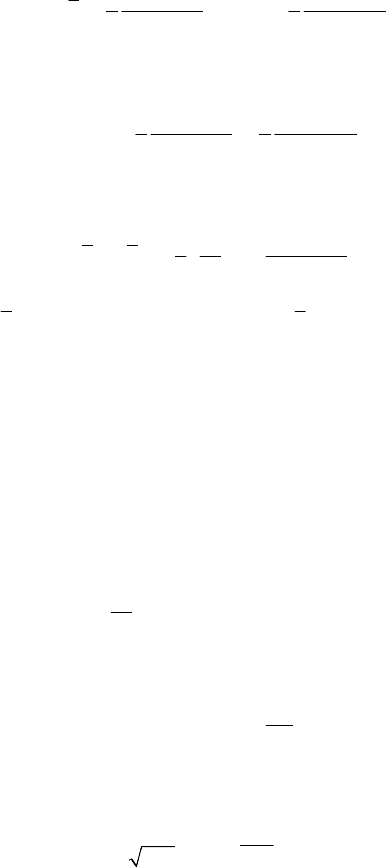
Problems of dynamics of the particle
417
To compare with the relation (7.1.30'''), we observe that
0
0
d
1
d
1()
v
t
gv
ϕ
=
+
,
0
0
0
1d
d
1()
v
t
g
vϕ
=
−
;
as well
00
00
0
0
d
11d
d
1()
1()
vv
vv
h
gvg
v
ϕ
ϕ
==
+
−
.
We get
()
(
)
00
0
0
0
d
1
d10
1()
vv
tt
gv
v
ϕ
−
=− ≥
+
,
so that
0
tt> (because for
0
0v
=
we have
0
0tt
=
= ); hence, in the air, the
falling time is greater than that of rising (for the same height
h ).
The integrals may be easily calculated for
()
n
vvϕλ
=
, n
∈
, 0n > , λ positive
constant.
1.2.4 Motion of a heavy particle constrained to stay on a curve
Let
P be a heavy particle constrained to move on a fixed curve C , neglecting the
resistance of the air; assuming that the
Ox -axis is directed along the local vertical,
opposite to the gravity acceleration, we may write the conservation theorem of
mechanical energy in the form
2
2
v
mmgxh
=
−+, consth
=
,
wherefrom
2
2( )vgax=−,
h
a
mg
=
.
(7.1.31)
Let be the plane
Π of equation xa
=
and P
′
the projection of the particle P on this
plane; the velocity of the particle
P is, in this case, given by
2vgh= , hPP
′
=
,
(7.1.31')
and is equal to that of a heavy particle which falls from
P
′
in P , without initial
velocity.
Let us suppose that the curve
C is closed. If the curve does not pierce the plane Π ,
that one being above it (we may assume to have an initial velocity
0
v for any initial
position
0
P of applicate
0
x , so that
2
00
/2ax v g=+ be as great as we wish), then the
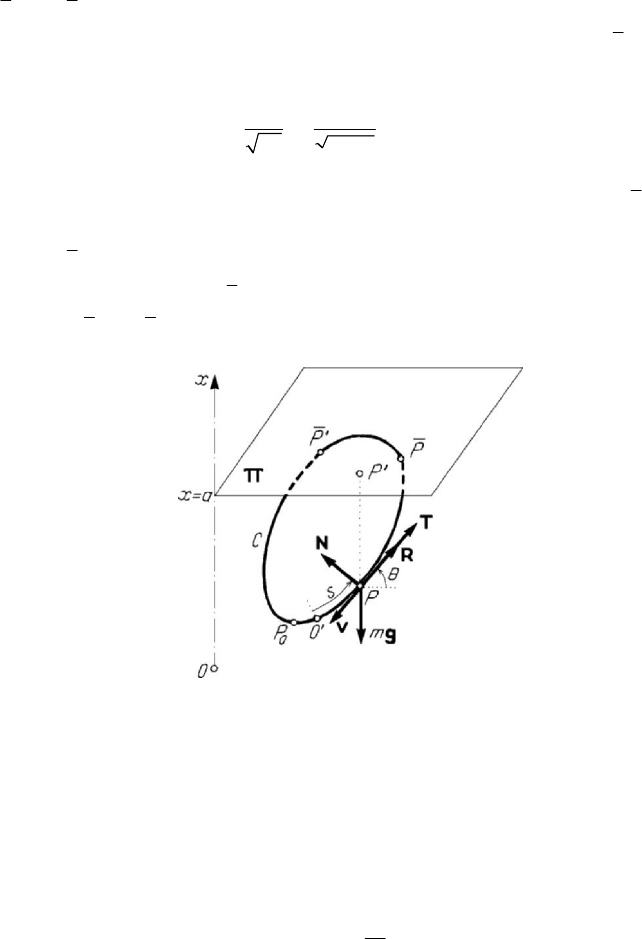
MECHANICAL SYSTEMS, CLASSICAL MODELS
418
formula (7.1.31') shows that the velocity does never vanish; the motion is periodic, the
point of maximal applicate having the minimal velocity, while that of minimal applicate
has the maximal one.
If the velocity
0
v is not sufficient great, the plane pierces the curve C at the points
P and P
′
(Fig.7.5). We suppose that the particle is launched from the point
0
P of
minimal applicate
0
x with the initial velocity
0
v ; it reaches the point P after an
interval of time
0
1d
2
a
x
s
T
ax
g
=
−
∫
,
(7.1.32)
where
ddsvt
=
is the element of arc on the arc
0
PP. If the tangent at P is not
horizontal, then the particle returns at
0
P in a time T with the velocity
0
v and then
reaches
P
′
in a time T
′
, which is calculated by the same formula (7.1.32), ds being
an arc element on the arc
0
PP
′
. Hence, the motion of the particle is oscillatory between
the points
P and P
′
, each simple oscillation being of duration TT
′
+
.
Figure 7.5. Motion of a heavy particle constrained to stay on a curve.
Let us consider now that the motion of the particle is with friction in a resistent
medium; for the sake of simplicity we assume that the curve
C
is situated in a vertical
plane. We choose an origin
O
′
for the curvilinear co-ordinate s . As well, we introduce
the normal constraint force
N , the tangential constraint force vers
f
N
=
−Tv, where
f
is the sliding friction coefficient, and the resistance ()versmg vϕ
=
−Rv. The
equations of motion in intrinsic co-ordinates are written in the form
[
]
sin ( )mv mg v fNθϕ=− − +
,
2
cos
v
mNmgθ
ρ
=− ,
(7.1.33)
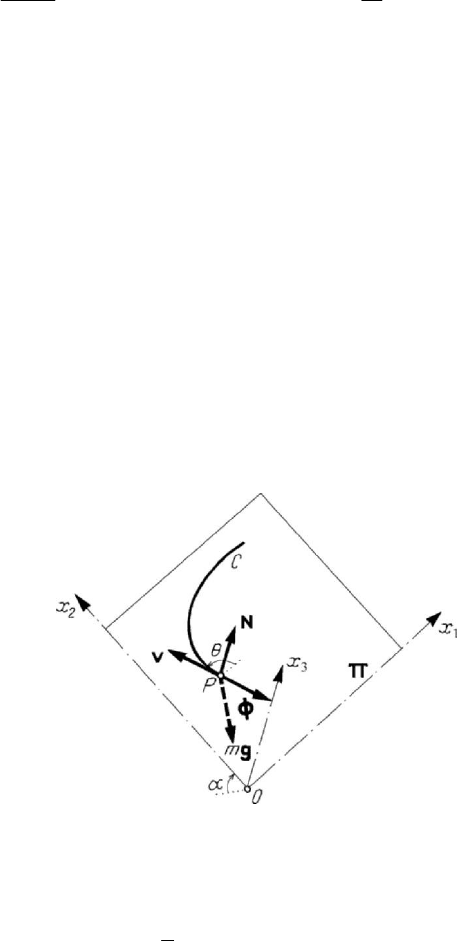
Problems of dynamics of the particle
419
where
ρ is the curvature radius, while θ is the angle formed by the tangent to the
curve
C with the horizontal line. Eliminating the constraint force N between the two
equations and noting that
(
)
2
2d /dvvs=
, we obtain the equation
(
)
[]
2
2
d
2sin cos () 2
d
v
v
gf vf
s
θθϕ
ρ
=− − − + ,
(7.1.33')
which determines the unknown function
()vvs
=
; then one may calculate s and t by
quadratures. The points on the curve for which
sin cos sin( )/ cos 0
f
θθθϕϕ
−
=− =
hence for which
θϕ= , where ϕ is the angle of sliding friction, represent limit
positions of equilibrium for the particle.
1.2.5 Motion of a heavy particle constrained to stay on a plane
Let be a heavy particle
P situated on a plane Π which makes the angle
0/2απ<≤ with the horizontal plane (Fig.7.6). Assuming a sliding friction of
coefficient
tan
f
ϕ= , the force of friction is Φ ,
f
NΦ
≤
, where N is the constraint
force, normal to the plane; taking into account the condition (4.1.50) and observing that
the given force has the magnitude
Fmg
=
and the normal component
cos
n
Fmgα=− , it results the condition of equilibrium
22
cos cosαϕ≥ . Hence, if
the angle
α is at the most equal to the angle of friction, then the particle is in
equilibrium in any position.
Figure 7.6. Motion of a heavy particle constrained to sliding friction on a plane.
If the particle is in motion and the mentioned condition is not fulfilled, then its
position will be given by the equation
mmfN
v
=− +
v
rg N
, cosNmg α
=
(7.1.34)

MECHANICAL SYSTEMS, CLASSICAL MODELS
420
in the plane
3
0x = ; choosing the axes
1
Ox (the intersection of the plane Π with the
horizontal one) and
2
Ox in this plane, we obtain
1
cos sin cos cosxv v fgθθθ αθ=− =−
,
2
sin cos sin cos sinxv v g fgθθθ α αθ=+ =−−
,
where
θ
is the angle made by the velocity v with the
1
Ox
-axis. It results
cos sin sinvfg gααθ=− −
, sin cosvgθαθ=−
,
wherefrom
(
)
dcot
tan
dcos
vf
v
α
θ
θθ
=+
;
(7.1.34')
this equation is of the form (7.1.23) and it may be analogously studied. Noting that
cot const
f
α = , we get
(
)
(
)
cot
0
00
cos cos tan cot
42 42
f
vv
α
θ
ππθ
θθ
⎡⎤
=−−
⎢⎥
⎣⎦
(7.1.34'')
and then
0
02
11
1
()d
sin
xx v
g
θ
θ
ϑϑ
α
=−
∫
,
0
02
22
1
()tand
sin
xx v
g
θ
θ
ϑϑϑ
α
=−
∫
,
(7.1.34''')
with
0
/2πθθ−<≤. We notice that
/2 0
for cot 1,
lim
0 for cot 1,
f
v
f
θπ
α
α
→− +
∞
<
⎧
⎪
=
⎨
>
⎪
⎩
assuming that
0
/2θπ< .
In the case of a horizontal plane (
0α
=
) it results
0θ
=
, hence
0
θθ= ; the motion
is rectilinear and uniformly delayed. The equation (7.1.34) can be decomposed in two
equations
mfN
v
=−
v
v
,
m
+
=gN 0
,
(7.1.35)
as the vectors are contained in the
Π -plane or are normal to this one. There results
Nmg= and the velocity
0
d
()
0
e
t
t
f
g
v
τ
τ
−
∫
=
vv ,
(7.1.35')
